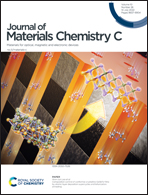High efficiency perovskite solar cells with PTAA hole transport layer enabled by PMMA:F4-TCNQ buried interface layer†
Abstract
Different interface engineering approaches have been adopted for development of high efficiency and stable perovskite solar cells (PSCs). In this work, we report our efforts for realizing high efficiency PSCs using a poly(methyl methacrylate) (PMMA):2,3,5,6-tetrafluoro-7,7,8,8-tetracyanoquinodimethane (F4-TCNQ)-modified poly(bis(4-phenyl)(2,4,6-trimethylphenyl)amine) (PTAA) hole-transporting layer (HTL). The results reveal that PMMA molecules on PTAA induce an interface dipole at the PTAA/perovskite interface, caused by the electrostatic interaction between the ester groups in the PMMA molecules and the electron-deficient N+ free radicals in the PTAA molecules. The existence of the PMMA-induced interface dipole at the PTAA/perovskite interface increases the built-in potential in the PSCs, resulting in a 60 mV increase in the open circuit voltage. The increase in the built-in potential aids in an efficient charge collection process. The incorporation of F4-TCNQ molecules into PMMA further promotes the hole extraction by creating an intermediate state. In addition, PMMA and F4-TCNQ, especially PMMA, also passivate interface defects and promote perovskite crystallization. As a result, the MAPbI3-based PSCs with a PMMA:F4-TCNQ-modified PTAA HTL achieve a power conversion efficiency of >20%, which is evidently higher than that of a control PSC with a pristine PTAA HTL (∼17%). Moreover, the stability of PSCs is also improved efficiently. Our findings unveil the importance of PMMA:F4-TCNQ interfacial modification for mitigating charge recombination loss through controlled growth of the perovskite semiconductor layer, reduced interface defects and high built-in potential for efficient operation of the PSCs.



 Please wait while we load your content...
Please wait while we load your content...